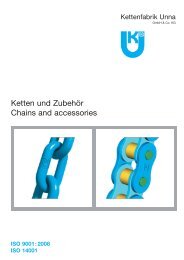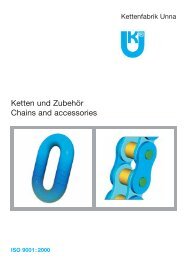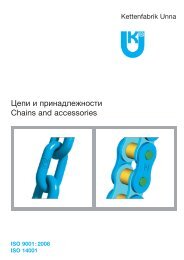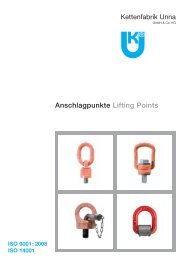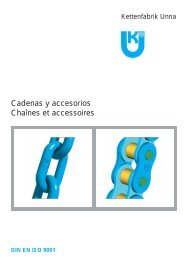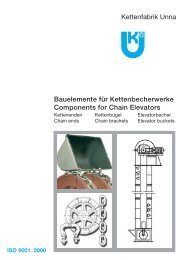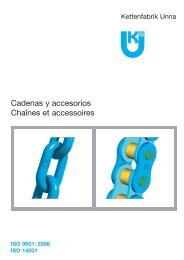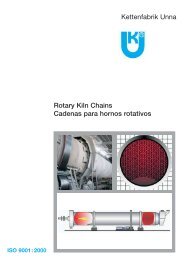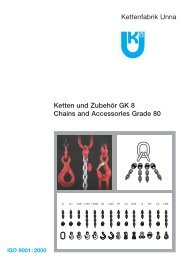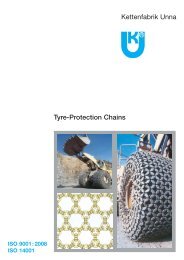8 - Kettenfabrik Unna GmbH & Co. KG
8 - Kettenfabrik Unna GmbH & Co. KG
8 - Kettenfabrik Unna GmbH & Co. KG
Sie wollen auch ein ePaper? Erhöhen Sie die Reichweite Ihrer Titel.
YUMPU macht aus Druck-PDFs automatisch weboptimierte ePaper, die Google liebt.
8<br />
16<br />
User Information / Instructions for Chain Sling Assembly<br />
1. Selection / Application of Chain Slings<br />
1.1 Prior to <strong>Co</strong>mmissioning<br />
Sling chains of quality class 8 should be properly mounted and identified. Only mount suitable components into the chain. Prior to use, inspect the sling<br />
chain for visual faults and proper function. Never use a sling chain which is composed of damaged component parts. Any chain sling to be used must<br />
be provided, pursuant to the provisions of EC Machinery Directive 2006/42/EG, with an identification tag containing the following minimum details:<br />
1. Chain dimensions and number of chain strands;<br />
2. Max. load capacity/safe working load of the sling chain considering the potential inclination angle;<br />
3. Identification of Manufacturer;<br />
4. CE symbol and year of production;<br />
5. Test certificates must be available (Declaration of <strong>Co</strong>nformity, Acceptance Protocol EN 10204 3.1 etc.)<br />
1.2 Principles of Application<br />
Do not stand or walk under suspended loads. Never load the sling chain beyond the permitted load capacity limits. Adhere to admissible angles of<br />
inclination, or use chains of a higher load capacity. Never load a chain which is twisted, remove the twist before loading. Do not use knotted chains.<br />
Protect the chains from sharp-edged loads using appropriate means; do not subject chains to a bending stress. Chain shortening is only allowed when<br />
using the component parts (such as shortening claws, shortening hooks) specifically provided to this purpose. During empty transport, hang the chain<br />
sling load hook into the suspension ring and lock safety hook.<br />
The suspension chain link of a sling chain must be freely moving in the crane hook of the lifting gear. Use a special suspension link, if necessary. Never<br />
hang the sling chain suspension link on to the tip of the lifting gear hook.<br />
Load hooks should be loaded in the base part of the hook bottom, never on its side, back or tip. No loading of the hook across sharp edges is allowed.<br />
Immediately repair or replace damaged hooks and safety catches.<br />
1.3 Type of Sling<br />
Sling loads so as to prevent the load or chain sling from damage. Chain slings can be slung on the load in a number of ways:<br />
1.3.1 Direct slinging with slinging points<br />
Hook and slinging points must match. The load must sit on the base of the hook. You are not allowed to load the hook tip. If you use multi-strand chain<br />
slings, make sure that the hooks face outwards.<br />
1.3.2 Slinging with tie straps (tying passage)<br />
In this case, pass one strand of the sling through or underneath a load and suspend the sling element into the chain. If you use the tying passage, only<br />
80% of the declared load capacity may be used. If you use two or more chain strands for tying, make sure that the tying procedure generates no moment<br />
of momentum to the load, and that the maximum angle of inclination does not exceed 60° (parallel tying passage).<br />
1.3.3 Slinging by slinging around (suspension passage)<br />
In this case, pass one strand of the sling chain through or underneath a load and suspend it directly in the burden hook. This type of slinging is generally<br />
used in pairs with two sling chains.<br />
1.4 Centre of Gravity<br />
To lift a load without the load being twisted or tilting, observe the criteria below:<br />
1.4.1 with single-strand chain slings and ring chains, the slinging point should be located vertically above the centre of gravity of the load;<br />
1.4.2 with double-strand chain slings, the slinging points should be located vertically above and to both sides of the centre of gravity of the load;<br />
1.4.3 with triple- and quadruple-strand chain slings, the slinging points should be evenly spaced in one plane around the centre of gravity of the load.<br />
Such spacing should be uniform, and the slinging points should preferably be located above the centre of gravity of the load.<br />
The centre of gravity of the load must always be located in the precise centre of the load. If you use multi-strand sling chains, make sure that you select<br />
the slinging points and chain types so that inclination angles are located within the areas specified. Preferably, all angles of inclination should be identical.<br />
Angles above 15° are safer because the load is suspended in a more stable way. The burden hook in which you hang the sling, should be located<br />
directly above the centre of gravity of the load.<br />
1.5 Symmetry of Load<br />
When using triple or quadruple strand sling chains, no more than three strands can be regarded as being load–bearing. You have to meet the requirements<br />
below, in addition to those above:<br />
1. The centre of gravity of the load must be located in the precise centre of the load.<br />
2. All chain strands of the sling chain must be inclined by the same angle.<br />
3. When using three chain strands, each individual chain strand must be arranged in an angle of 120° to each other.<br />
Load distributed must be expected to be asymmetric if there are different angles of inclination or if you do not know the centre of gravity of the load.<br />
Reduce the load-bearing capacity of the sling chain to that of a double-strand sling chain of the same diameter with application of the maximum admissible<br />
inclination angle.<br />
If you use multi-strand sling chains, and the individual strands are not inclined by identical angles, the highest stress will be generated in the single strand<br />
inclined by the smallest angle. In extreme cases, the entire load will be carried by one single vertically suspended strand.<br />
1.6 Usage Under Environmental Influences<br />
1.6.1 Influences of Temperature<br />
Temperatures will have the following influence on quality class 8 sling chains:<br />
Temperature Load capacity<br />
< -40°C 0%<br />
-40 – +200°C 100%<br />
+200 – +300°C 90%<br />
+300 - +400°C 75%<br />
> +400°C 0%



